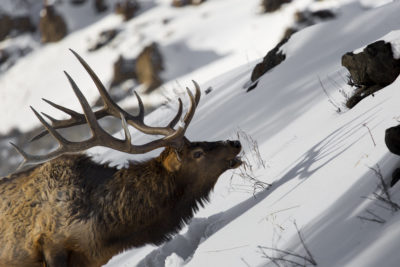Mari Carroll
The long legs of a cow elk step easily through the deep snow. Part of a small herd led by a lead cow, she is making her way to join larger herds. During the summer months, small groups of elk roam the higher elevations, but during the winter, these herds will join with others at lower elevations. They find valleys and places where the snow is less deep. This female’s herd consists of mostly cows, their calves, and a couple of spikes. These one-and-half-year-old males will stay with the herd for a couple more months.
As summer ends, the elk’s winter coat has grown a thicker and woollier undercoat to insulate against the winter temperatures. Long, thick guard hairs develop to keep her dry. This winter coat is five times warmer than her summer coat. On colder, sunless days or at night, the herd will move to north and east slopes to catch more sun. During the mid-day, the herd will rest to help conserve energy. When the cow elk finds a nice spot, she lies down and pulls her legs in close; this way she can keep her body temperature up and herself warmer. She is currently pregnant; most of the cows in the herd are.
As she moves through the snow in the early morning, she searches for food. In the winter, her diet consists of woody shrubs, tree bark, grasses, and twigs. When she and the other elk are eating, they are most vulnerable. They must all do their part to keep an eye out for predators. Her large eyes on the sides of her head give her a 360-degree view, allowing her to watch the calves, running around playing with each other; their chips and mews can be heard throughout the group. At 8 months old, these calves weigh around 150-250 pounds.
It takes 20 hours for an elk to digest its food. She has four chambers in her stomach because she is a ruminate. The first chamber in her stomach is called the rumen or the holding tank; when she first swallows her food, it is stored here. This way, if a predator finds her while she is eating, she can alert the others, and the elk can quickly run away and defend themselves. When she is in a safe space, she will bring that food back up and chew on it. This is called cud. After it is sent to her other stomachs for digestion: first the reticulum, then the omasum, and finally the abomasum. Her digestion will help act like a furnace, keeping her warm during the cold winter days. Because food is less available in the winter, the cow elk will try to conserve her energy, only moving when necessary.
During the winter, not many bull elk are in her herd. In bachelor groups, they hang around the outskirts. Once the winter becomes harsher, the bull elk join the herd of cows and their young. They are the last to join and the first to leave. During the mornings and at dusk, they can be seen sparring with each other. Since the rut is now over, their sparing is more for practice. These bull elk still have their antlers and will not shed them till mid-March.
After the harsh winter months in the spring when the elk is ready to give birth, she goes to a more secluded area. When a calf is born, it weighs about 35 pounds. The mother will leave her calf to find food for herself, only returning to feed it. This actually provides more protection for the young calves that do not have a scent and won’t attract predators. If the mother stays near it, predators will be able to find it more easily. Once the calf is strong enough, the small herds will join back up for the summer months, repeating the process begun the previous year, continuing the cycle of life.

Bull Elk, Yellowstone National Park (Photo: NPS, Neal Herbert)
Mari is a 2021 Naturalist for SIHA. She is from Utah and has spent the past couple of winters working at a wildlife management area with a focus on elk. During the winter, she had the opportunity to observe the elk, help test for diseases, and provide interpretation for visitors viewing the herd. Elk are among her favorite animals.
Sources: